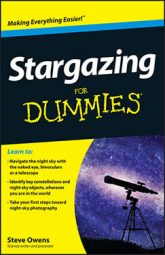The first time you take your binoculars out stargazing, you may be disappointed to find that all the stars, planets and faint fuzzies that you’d planned on observing are dancing all over the place when you look through the eyepieces. Don’t worry, the universe isn’t moving; it’s just you.
No matter how still you try to hold your binoculars, small wobbles in your arm, hands or head, and even your breathing, will cause the stars to move to such an extent that you may struggle to see much. So you need to find a way of steadying your binoculars to reduce the wobble.
You can try balancing your binoculars on a nearby wall or perhaps your car roof or some other solid surface, but even these steady surfaces won’t cure the view of all wobbles. You’ll still have to hold your binoculars with your hands, and that means you’re the limiting factor.
Some high-tech binoculars have image-stabilising hardware that reduces the wobble, giving you a stiller image. Imagestabilised (IS) binoculars aren’t cheap. However, you may be able to find a small pair of IS binoculars that give you a better view than a non-IS pair. If you can afford a lower-power set, which saves a bit of money over a high-power set, that’s the way to go.
Tripods for stargazing: Three legs to stand on
Tripods are great additions to your stargazing kit, especially if you’re using binoculars. By attaching your binoculars to a tripod, you instantly steady the image, because you don’t have to touch the binoculars at all. You can’t attach all binoculars to a tripod, though, so you need to find out whether you’ll be able to fix yours on or not.
Some binoculars have a screw thread with which you can use an adaptor to attach them to a tripod. To find this screw thread, you may need to remove a small plastic covering cap, which will be hiding it from view. Most often, you can find the screw thread in the central bar of the telescope at the front, between the two objective lenses.
If your binoculars don’t have a screw thread to attach them to a tripod, you may be able to use an adaptor that clamps onto the pivot bar between both barrels of the binoculars.
If the surface your tripod is standing on isn’t solid, or if it’s windy, you still may have a bit of a wobble. The best place for binoculars on tripods is somewhere sheltered that’s firm underfoot.
Monopods for stargazing: One leg to stand on
In some cases, a tripod can be a bit awkward to manoeuvre around, especially if you’re planning on observing lots of different targets in the sky. The next best thing to a tripod is a monopod, which is really just a one-legged tripod.
‘But won’t it fall over?’ I hear you ask. No, not if you hold onto it! But if you’re holding the monopod, you may wobble and cause the image to jump about, and keeping the monopod steady is far more difficult that keeping a tripod steady. Having said that, monopods do have their uses. They:
Are lighter and more portable than tripods
Allow you to take the weight of your binoculars off your arms
Steady the image more than you can just by holding the binoculars
Make it easier to pivot the binoculars around to look at many different objects
Binocular stargazing with a tripod or monopod
After you’ve mounted your binoculars on a tripod or monopod, you’re almost ready to start some serious stargazing! One final thing you’ll have to consider is how to get comfortable looking through the eyepieces.
Most tripods won’t extend high enough to raise the eyepieces to a comfortable height, so you’ll have to stoop. And if the thing you’re looking at is high overhead, you may have to simultaneously stoop and crane your neck, which isn’t exactly a comfortable position to be in.
One of the best ways to overcome this awkwardness is to stargaze while sitting or lying on a reclining outdoor chair. Now that’s stargazing in comfort! This position is where a monopod comes into its own, as it’s much easier to move around than a tripod.
If you’re stargazing from a chair, make sure that you dress warmly and put a blanket between yourself and the chair for insulation. If you’re not moving about much, you can cool down pretty quickly.

